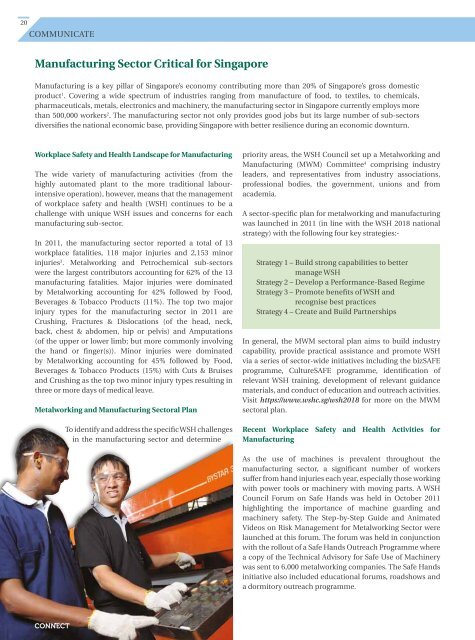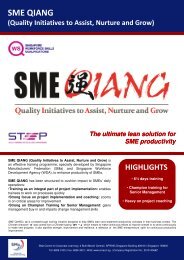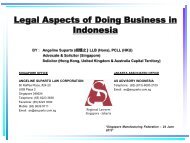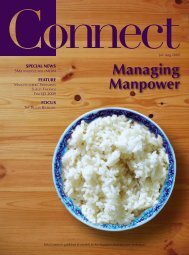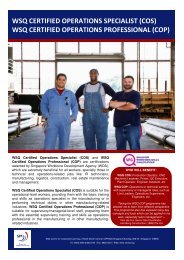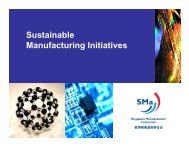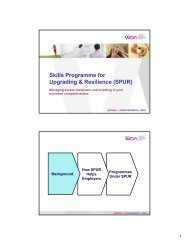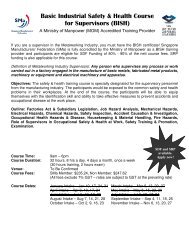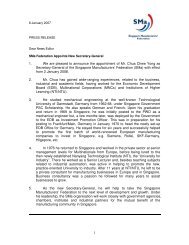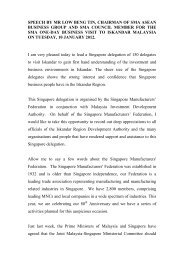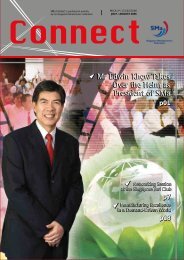CONNECT Issue 4/2012 - Singapore Manufacturing Federation
CONNECT Issue 4/2012 - Singapore Manufacturing Federation
CONNECT Issue 4/2012 - Singapore Manufacturing Federation
Create successful ePaper yourself
Turn your PDF publications into a flip-book with our unique Google optimized e-Paper software.
20<br />
Communicate<br />
<strong>Manufacturing</strong> Sector Critical for <strong>Singapore</strong><br />
<strong>Manufacturing</strong> is a key pillar of <strong>Singapore</strong>’s economy contributing more than 20% of <strong>Singapore</strong>’s gross domestic<br />
product 1 . Covering a wide spectrum of industries ranging from manufacture of food, to textiles, to chemicals,<br />
pharmaceuticals, metals, electronics and machinery, the manufacturing sector in <strong>Singapore</strong> currently employs more<br />
than 500,000 workers 2 . The manufacturing sector not only provides good jobs but its large number of sub-sectors<br />
diversifies the national economic base, providing <strong>Singapore</strong> with better resilience during an economic downturn.<br />
Workplace Safety and Health Landscape for <strong>Manufacturing</strong><br />
The wide variety of manufacturing activities (from the<br />
highly automated plant to the more traditional labourintensive<br />
operation), however, means that the management<br />
of workplace safety and health (WSH) continues to be a<br />
challenge with unique WSH issues and concerns for each<br />
manufacturing sub-sector.<br />
In 2011, the manufacturing sector reported a total of 13<br />
workplace fatalities, 118 major injuries and 2,153 minor<br />
injuries 3 . Metalworking and Petrochemical sub-sectors<br />
were the largest contributors accounting for 62% of the 13<br />
manufacturing fatalities. Major injuries were dominated<br />
by Metalworking accounting for 42% followed by Food,<br />
Beverages & Tobacco Products (11%). The top two major<br />
injury types for the manufacturing sector in 2011 are<br />
Crushing, Fractures & Dislocations (of the head, neck,<br />
back, chest & abdomen, hip or pelvis) and Amputations<br />
(of the upper or lower limb; but more commonly involving<br />
the hand or finger(s)). Minor injuries were dominated<br />
by Metalworking accounting for 45% followed by Food,<br />
Beverages & Tobacco Products (15%) with Cuts & Bruises<br />
and Crushing as the top two minor injury types resulting in<br />
three or more days of medical leave.<br />
Metalworking and <strong>Manufacturing</strong> Sectoral Plan<br />
To identify and address the specific WSH challenges<br />
in the manufacturing sector and determine<br />
priority areas, the WSH Council set up a Metalworking and<br />
<strong>Manufacturing</strong> (MWM) Committee 4 comprising industry<br />
leaders, and representatives from industry associations,<br />
professional bodies, the government, unions and from<br />
academia.<br />
A sector-specific plan for metalworking and manufacturing<br />
was launched in 2011 (in line with the WSH 2018 national<br />
strategy) with the following four key strategies:-<br />
Strategy 1 – Build strong capabilities to better<br />
manage WSH<br />
Strategy 2 – Develop a Performance-Based Regime<br />
Strategy 3 – Promote benefits of WSH and<br />
recognise best practices<br />
Strategy 4 – Create and Build Partnerships<br />
In general, the MWM sectoral plan aims to build industry<br />
capability, provide practical assistance and promote WSH<br />
via a series of sector-wide initiatives including the bizSAFE<br />
programme, CultureSAFE programme, identification of<br />
relevant WSH training, development of relevant guidance<br />
materials, and conduct of education and outreach activities.<br />
Visit https://www.wshc.sg/wsh2018 for more on the MWM<br />
sectoral plan.<br />
Recent Workplace Safety and Health Activities for<br />
<strong>Manufacturing</strong><br />
As the use of machines is prevalent throughout the<br />
manufacturing sector, a significant number of workers<br />
suffer from hand injuries each year, especially those working<br />
with power tools or machinery with moving parts. A WSH<br />
Council Forum on Safe Hands was held in October 2011<br />
highlighting the importance of machine guarding and<br />
machinery safety. The Step-by-Step Guide and Animated<br />
Videos on Risk Management for Metalworking Sector were<br />
launched at this forum. The forum was held in conjunction<br />
with the rollout of a Safe Hands Outreach Programme where<br />
a copy of the Technical Advisory for Safe Use of Machinery<br />
was sent to 6,000 metalworking companies. The Safe Hands<br />
initiative also included educational forums, roadshows and<br />
a dormitory outreach programme.


